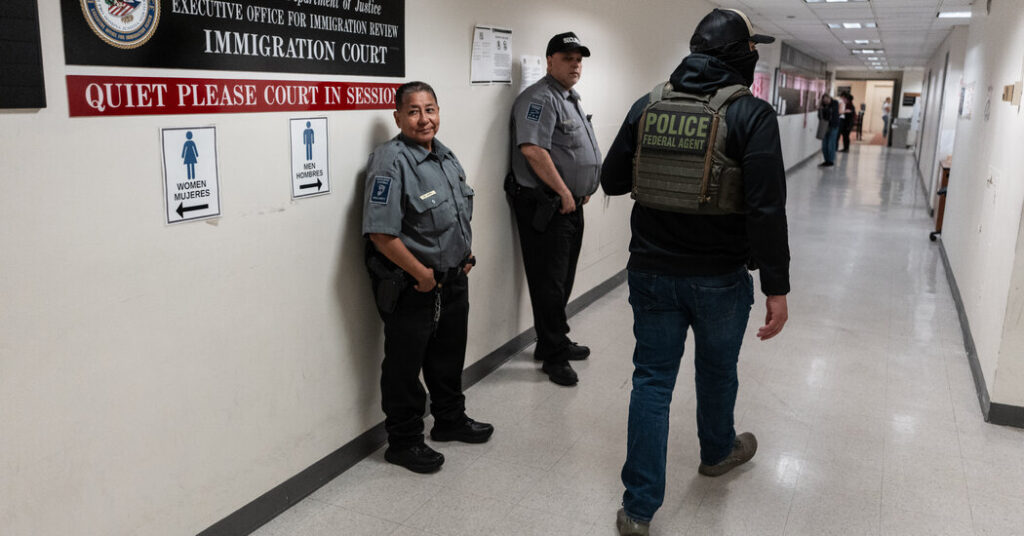For at least five days, a blind Ecuadorean man who was arrested this month in New York City by U.S. immigration authorities was held in isolation at a county jail, locked in his cell for 24 hours a day and deprived of his cane.
“I feel so terrible I cannot see and that I cannot walk, read or do things on my own,” Carlos Anibal Chalco Chango, 40, said last week in a declaration prepared by his lawyers based on their conversations with him.
On Monday night, after days of pressure from the lawyers, the U.S. Immigration and Customs Enforcement agency relented: Mr. Chalco Chango was released from the Orange County jail in upstate New York. It was a surprising move by an agency that rarely releases detainees under President Trump.
The two-week effort by his lawyers to free him came amid pitched legal battles playing out across the United States, as lawyers file emergency motions to have ICE release migrants who are being subjected to mandatory detention.
Unlike Mr. Chalco Chango, many of the more than 60,000 immigrants in detention don’t have lawyers. Most are forced to fight deportation alone, leaving many to consider the Trump administration’s offers to leave the country voluntarily to avoid months in jail.
What distinguished the Ecuadorean man’s case was his disability.
ICE agents arrested Mr. Chalco Chango on Nov. 4 as he was leaving his home in Corona, Queens, an immigrant-rich neighborhood where advocates and local officials have documented an increase in arrests of mostly Hispanic men this month.
The federal immigration agents were seeking to arrest Mr. Chalco Chango’s 20-year-old son, and they approached the older man to show him a picture of their “intended target” on a cellphone, according to government filings.
Mr. Chalco Chango told them that he was blind and could not see the image, according to his lawyers, who said the agents pushed him against a wall, handcuffed him and put him inside a car. An agent told him in Spanish to call his son and tell him to turn himself in, his lawyers said. Then, the agent said, Mr. Chalco Chango would be free to go.
But when Mr. Chalco Chango’s son showed up, the agents arrested him, too. Both men were whisked away to 26 Federal Plaza, the ICE offices in Lower Manhattan, setting off the legal saga to release him.
The federal government said in filings that the agents had “engaged in a consensual conversation” with Mr. Chalco Chango, who they said “freely admitted to the officers” that he had no legal status.
Mr. Chalco Chango crossed the southern border into the United States with his son in 2023. Border Patrol agents who encountered them released them to seek asylum, according to filings.
After his Nov. 4 arrest, Mr. Chalco Chango was placed in a holding cell at 26 Federal Plaza, where he was barred from having his cane or using a text-to-audio phone app that could help him read legal documents.
After a judge, Andrew L. Carter Jr. of Manhattan federal court, ruled that Mr. Chalco Chango could not be removed from the country, ICE moved him on Nov. 8 to the Orange County jail.
There, officials said they had “serious concerns” about safely accommodating him in the jail’s general population because of his blindness, according to a court filing by the office of Jay Clayton, the U.S. attorney for the Southern District of New York.
In a letter on Monday informing Judge Carter of Mr. Chalco Chango’s release, the government said it considered the case moot, a suggestion that no further proceedings over his detention were necessary. The judge directed the parties to send him a joint letter by Thursday addressing whether they agreed that the case was moot, though Mr. Chalco Chango’s separate immigration case still appears unresolved.
Paige Austin and Harold A. Solis, lawyers at Make the Road New York, an advocacy group representing Mr. Chalco Chango, said in an interview on Tuesday that they wanted assurances from ICE that their client would not be detained in the future.
ICE did not immediately respond to a request for comment.
In his declaration to the court, Mr. Chalco Chango described, in vivid detail, feeling helpless while in isolation in the jail.
He thought his cell might have a clock, he said, but he could not see it. He could, however, detect when people were outside the cell by the shadows they cast.
So when he saw shadows, he added, “I try to ask through the door — what time is it?”
Benjamin Weiser is a Times reporter covering the federal courts and U.S. attorney’s office in Manhattan, and the justice system more broadly.
The post ICE Frees Blind Migrant Who Was Detained for Days in Isolation appeared first on New York Times.




